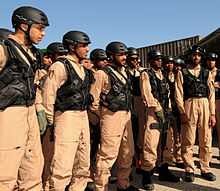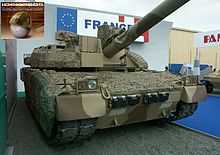Union Defence Force (UAE)
| Military of the United Arab Emirates | |
|---|---|
|
BMP-3 infantry fighting vehicles of the UAE military offloading | |
| Founded | 1951 |
| Current form | 1971 |
| Service branches |
United Arab Emirates Army United Arab Emirates Navy United Arab Emirates Air Force |
| Manpower | |
| Military age | 18 years |
| Available for military service | 752,707, age 15-49 (2004) |
| Fit for military service | 412,490, age 15-49 (2004) |
| Reaching military age annually | 24,506 (2004) |
| Active personnel | 65,000 (ranked 73rd) |
| Expenditures | |
| Budget | US$15.7 billion in 2010 (ranked 18th) |
| Percent of GDP | 7.3% |
| Industry | |
| Foreign suppliers |
|
The Union Defence Force is the armed forces of the United Arab Emirates and has primary responsibility for the defense of all seven emirates. It consists of 70,500 personnel, and is headquartered in Abu Dhabi, UAE.
History
The Trucial Oman Scouts, long the symbol of public order on the coast and commanded by British officers, were turned over to the United Arab Emirates as the nucleus of its defence forces in 1971.
Although initially small in number, the UAE armed forces have grown significantly over the years and are presently equipped with some of the most modern weapon systems, purchased from a variety of outside countries, mainly France, the US and the UK (the former protector of the UAE). Most officers are graduates of the United Kingdom's Royal Military Academy at Sandhurst, with others having attended the United States Military Academy at West Point, the Royal Military College, Duntroon and St. Cyr, the military academy of France. France opened the Abu Dhabi Base in May 2009. In March 2011, the UAE agreed to join the enforcement of the no-fly-zone over Libya by sending six F-16 and six Mirage 2000 multi-role fighter aircraft.[1] During the Gulf war, the US had troops and equipment stationed in the UAE as well as other parts of the Persian Gulf.
Organization
There are two distinct military organizations in the UAE, the UAE federal military force is called the Union Defence Force, and then several of the Emirates maintain their own forces.
Federal Forces
UAE Army
As part of the military of the United Arab Emirates the United Arab Emirates Ground Force is responsible for land operations.
UAE Air Force
The United Arab Emirates Air Force has about 4000 personnel.[2] The air force agreed in 1999 to purchase 80 advanced U.S. F-16 multirole fighter aircraft. Other equipment includes the Mirage 2000s, British Hawk aircraft, Eurofighter Typhoon, and French helicopters. The air defense has a Hawk missile program for which the United States has been training. The UAE has taken delivery of two of five Triad I-Hawk batteries.
UAE Air Defence Force
- United Arab Emirates Air Defence Force
Responsible for aircraft's.
UAE Navy
The United Arab Emirates Navy is growing, with more than 2,000 personnel and 72 vessels.
- United Arab Emirates Marines - The UAE maintains a small battalion sized marine force called the UAE Marines. It is equipped with BMP-3s.
- United Arab Emirates Coast Guard - The United Arab Emirates Coast Guard is the official coast guard agency of the United Arab Emirates and is primarily responsible for the
Paramilitary forces
- Federal Police Force
Former Emirate forces
Four Emirates maintained their own forces prior to the unification of the defence forces. They were theoretically merged into the Union Defence Force in 1976, but in practice remained under emirate control and procured weapons separately for some time after.
- Abu Dhabi Defence Force - Formed in 1965, drawing on tremendous oil wealth, the Emir of Abu Dhabi gave high priority to the development of the Abu Dhabi Defence Force (ADDF) when the British withdrawal from the Persian Gulf was announced. The officer corps were mainly British and Jordanian. By 1975 it had grown to 15,000 men with two squadrons of Dassault Mirage III fighters and Dassault Mirage 5 attack aircraft, a squadron of Hawker Hunter fighter-bombers, 135 armoured vehicles, Rapier and Crotale missiles, Aérospatiale Alouette III and Aérospatiale Gazelle helicopters, and a sea defence wing of four fast patrol boats.[3] The ADDF became the Western Command of the UDF in 1976.
- Dubai Defence Force - Formed in 1971, by 1975 the DDF had 3,000 men with Ferret and Saladin armoured cars.[3] It later expanded to 20,000 men in one infantry brigade group, Aermacchi MB-326 ground attack aircraft and MBB Bo 105 helicopters. The DDF became the Central Command of the UDF in 1996.
- Ras al-Khaimah Mobile Force - Formed in 1969, it initially had 300 men with Ferret and Saladin armoured cars, organised into one armored squadron and two infantry squadrons. It eventually expanded to 9,000 men. It became the Northern Command of the UDF in 1996.
In addition, the Sharjah National Guard was formed in 1972. It was essentially a paramilitary force of 500-600 men with Shorland armoured cars. It merged with the Federal Police in 1976.[3]
Deployments
The UAE sent forces to assist Kuwait during the 1990-1991 Gulf War where several hundred UAE troops participated in the conflict as part of the GCC Peninsula Shield force that advanced into Kuwait City. The U.S. 363rd Tactical Fighter Wing (Provisional) operated from Al Dhafra Air Base in Dubai, and US ships operated out of UAE ports. The UAE air force also carried out strikes against Iraqi forces. A total of six UAE combat deaths were reported as a result of the fighting.
It dispatched an infantry battalion to the United Nations UNOSOM II force in Somalia in 1993, it sent the 35th Mechanized Infantry Battalion to Kosovo, and sent a regiment to Kuwait during the Iraq War. In addition, it helps protect the Persian Gulf and Strait of Hormuz. It is a leading partner in the campaign against terrorism, providing assistance in the military, diplomatic, and financial arenas. The UAE military provides humanitarian assistance to Iraq.
UAE Military field engineers arrived in Lebanon at September 8, 2007 in Beirut for clearing areas of south Lebanon from mines and cluster bombs. A UAE deployment in Afghanistan started in 2007.
Military expansion (1991–2005)


The UAE went on an expansion drive in 1995, which began with the 1992-93 acquisition of 436 Leclerc Tanks and 415 BMP-3 Armored Vehicles. It had learned from the Iranian experiences with having a single supplier for its military and has diversified its arms purchases, purchasing weaponry mainly from Russia, the United States, the UK, Ukraine, France, Italy and Germany. It has also taken care to invest in the systems it has purchased and standardize them according to NATO/GCC Specifications.
The equipment purchases was also followed by a programme to increase manpower numbers and Emiratisation program for the Armed forces. Presently (2005) almost all pilots in the UAE Air Force are UAE nationals, with the restriction of non-nationals to certain positions in the instruction and maintenance divisions of the airforce. More nationals are being trained to fill these ranks, with programs such as the Technical Trainee Project underway to try to fill the technical jobs in the country.
There has also been a qualitative shift in the Personnel in the armed services, with expert instruction being brought in from around the world, refinement of local military training institutions and the increase in standards across the armed forces. In 2008, the UAE bought Patriot missiles[4] and related radar, support services for the Patriot systems. There has been work concurrently on the Hawk systems, the Patriots predecessor, currently in use by the UAE.
In the last days of 2011, during a war scare with Iran over the Straits of Hormuz, the UAE announced a purchase of US $3.48 billion worth of American missile systems: 2 radar systems, 96 missiles, spare parts and training.[4] The UAE was the first country to acquire the Terminal High Altitude Area Defense System (THAAD). A contract worth $1.96 billion was agreed for Lockheed Martin Corp to supply two Thaad anti-missile batteries.[5]
Military industry
The UAE has begun to produce a greater amount of military equipment in a bid to reduce foreign dependence and help with national industrialization. The Abu Dhabi Shipbuilding company - ADSB () produce a range of ships and are a prime contractor in the Baynunah Program, a program to design develop and produce 5-6 corvettes customized for operation in the shallow waters of the Persian Gulf. It has also produced and is producing ammunition, military transport vehicles and Unmanned Aerial Vehicles.
In 2007, the first small arm ever produced in UAE, the Caracal pistol, was introduced at IDEX. It became the official sidearm of the UAE armed forces and security forces. The National Guard of Bahrain adopted it shortly thereafter. Jordan ordered an unspecified number of pistol in April, 2008 during SOFEX, the Special Forces Exhibition held in Jordan. UAE and Algeria established on November, 17th, 2008 a joint committee in order to test the Caracal pistol for further adoption by Algeria.
A joint venture agreement was signed in Abu Dhabi on November 28, 2007 between Tawazun Holding LLC, an investment company established by the Offset Program Bureau (OPB), Al Jaber Trading Establishment, part of Al Jaber Group, and Rheinmetall Munitions Systems, to set up the Al Burkan munition factory at the Zayed Military City in Abu Dhabi.
The OSP signed four Memorandums of Understanding with leading companies from Europe and Singapore at the Paris Eurosatory 2008 defense exhibition on Junen 20th, Rheinmetall Group and Diehl Defence Holding of Germany, Singapore Technologies Engineering (ST Engg), and Thales of France.
Tawazun has also partnered with Saab on radar development.[6]
Military expenditures
- 1999: $2,100,000,000 (1.8% of Gross Domestic Product)
- 2000: $2,600,000,000 (0.8% of Gross Domestic Product)
- 2005: $3,800,000,000 (1.0% of Gross Domestic Product)
- 2010: $10,000,000,000
Gallery
-

United Arab Emirates F-16 Block 60 taking off after taxiing out of the Lockheed Martin plant in Fort Worth, TX. (NAS Fort Worth JRB)
-
Several Emirate Mirage 2000 over Afghanistan in 2008.
-

A United Arab Emirates Navy Super Puma helicopter
References
- ↑ "BBC News - Libya no-fly zone: Coalition firepower". BBC News. Retrieved 25 December 2014.
- ↑ "United Arab Emirates". U.S. Department of State. Retrieved 25 December 2014.
- ↑ 3.0 3.1 3.2 H. Richard Sindelar III and John E Peterson (1988). Crosscurrents in the Gulf: Arab Regional and Global Interests. Routledge. p. 213-213.
- ↑ 4.0 4.1 "Gulf States Requesting ABM-Capable Systems". Defense Industry Daily. 2 October 2014. Retrieved 25 December 2014.
- ↑ "US bolsters UAE's missile defense in major arms deal". Retrieved 25 December 2014.
- ↑ April Yee. "Abu Dhabi's Tawazun putting new eyes on the skies with radar deal". Retrieved 25 December 2014.
Further reading
- Britain, the UAE, and the defence of the Gulf revisited, International Affairs (journal), September 2013
External links
| Wikimedia Commons has media related to Military of the United Arab Emirates. |
![]() This article incorporates public domain material from the CIA World Factbook document "2003 edition".
This article incorporates public domain material from the CIA World Factbook document "2003 edition".
| ||||||||||
| ||||||||||||||||||||||||||||||||||||||||||

